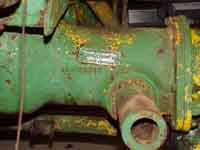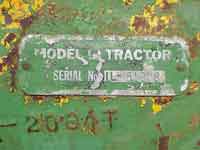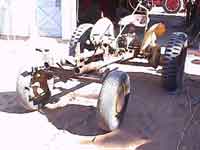Identify the year of an LI without the serial number tag
Maybe.......if you are lucky!
First, IS IT an LI?
For LIs built 1941 and after, often the letters "LI" are stamped into the top of the transmission, an inch or so in front of the seat support. LAs often had LA stamped there, and Ls usually had nothing there.
Frame differences
There were three types of frames in LI production, and if John Deere had used the frames that they were supposed to (according to parts books). However Deere often mixed the frame types during production, and made it impossible to get a definite break between frames. However, this is the way it was SUPPOSED to work:
- Thin Wall, Tube-(Just over 1/4 of an inch thick) 1938 unstyled tractors, and 1938 styled tractors
- Thick Wall, Tube-(.560 of an inch thick, or barely over 1/2 inch) 1939 through 1940
- Solid frame-1941 and onward
However there were exceptions. One source said that he has seen Thick Wall frames on some tractors built during World War Two (1941-1945, for U.S.A. I hope you knew this!) He believes that Deere was using up the parts that it had in stock. This could be true. I believe that it may have been caused by limited supplies of metal. John Deere could have reverted to this frame to save material. My opinion! Another source said that the solid frames weren't common at all in the LI production!
Yet another source said that he had seen the Thin wall frames used on serial numbers after the Thick walls were introduced. Can Deere ever make anything easy? That would be nice!
An couple owners have even provided photographic proof!


This LI has the "Thick Wall" frame, even though is it supposed to have the solid frame.

This LI has the "Thin Wall" frame, even though is it supposed to have the solid frame.
Shifter and Transmission differences for the LI (or normal L)
Info taken directly from an email. This is great! Thanks!
At serial number 629000 (which is about 2/3 of the way thru the '39 model year), the gear ratios changed, affecting the travel speed as follows:
| Gear |
Speed Before |
Speed After |
| 1st |
2.50 |
2.00 |
| 2nd |
3.75 |
3.50 |
| 3rd |
6.00 |
6.50 |
| Reverse |
3.75 |
2.50 |
The easiest way to check would be to compare the turns of the rear wheel vs. the driveshaft turns, while in reverse - since this is the biggest change in ratio. Of course, jacking one rear wheel up and turning the driveshaft will produce double the wheel revs, due to the differential action.
Or...you could do it the REALLY easy way! Tractors prior to 629000 had a "bent" shift lever, but those after used a straight shift lever! One glance, and you're done! No need to jack up the tractor.
Go back to the LI
Go back home


